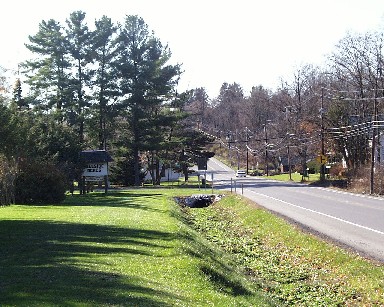December 21, 2003
Mobile homes
While the Draft Comprehensive Plan notes the existence of mobile homes in Dryden, it doesn't talk much at all about their future. It recognizes that:
Manufactured housing (a.k.a. mobile homes) accounts for a significant proportion of the housing stock. There are an estimated 1,150 manufactured homes in the town, of which approximately 890 are located within 17 mobile home parks.
In Varna, the Hillside Acres park contributes substantially to the existing density of the place. While the hamlet along 366 is packed fairly tightly, the park is mostly smaller mobile homes on small plots of land.

Looking toward Hillside Acres in Varna (map)
Mobile homes and mobile home parks are a fairly distinctive sign that you've entered the Town of Dryden from Ithaca, especially along Game Farm Road, Route 366, and Hanshaw Road. (The same thing happens when you leave the Town of Ithaca and enter Enfield or Newfield.)
Mobile homes occupy an important role in housing generally. They provide low-cost housing to lots of people and a way for them to accumulate equity in their homes, especially when they own the property on which the mobile home rests. They're frequently held up as an example of how the market can provide housing for people with lower incomes without the need for government intervention, though there are both cases of government intervention (HUD certifications for construction) and some fairly ugly stories of the market treating people badly.
Wheel Estate: The Rise and Decline of Mobile Homes, by Allan D. Wallis (Johns Hopkins University Press, 1990, Amazon) provides a thorough history of these houses, from the days when Hammondsport native Glenn Curtiss built them as luxury travel to their current lives as recreational vehicles and permanent housing.
Mobile homes have created a lot of issues over the years. One of the first ordinances in the zoning amendments packet the Town hands out with the zoning regulations, passed in 1989, bars mobile homes without HUD certification (pre-1976 houses) from being used in the town except where they already exist, even if they're used to replace an existing uncertified home. The last amendment in my copy is from 1998, and strikes the clauses permitting mobile homes in R-B-1, R-C, and R-D zones, huge swathes of property.
It looks like Dryden has effectively ruled mobile homes out for large parts of the town, but still has lots of them and lots of parks. What should the future of the parks be? They're an effective source of housing for people with lower incomes, they provide the kinds of densities that the Draft Comprehensive Plan seeks, and yet they're not mentioned at all in the sections looking forward.
While it seems unlikely that a developer will want to buy up parks in Dryden and redevelop them for other purposes, it's a real problem in a lot of parts of the country. When the money to be had from renting land and providing services to mobile homes isn't as good as another option, owners frequently sell. The laws don't provide much protection for the residents of the mobile homes, as the laws take the designation "mobile" seriously. But where can people take their homes, even if (a big if) they can move them? This might be an issue better discussed as part of a planning process rather than hoping the problems never arise.
Even if the official policy on mobile homes is to discourage them and hope for the best, some discussion of how mobile home parks fit into the planning for new water districts might be a good idea, as a lot of the area highlighted in Proposed New Water & Sewerage Service Areas, particularly the area west of Etna, already includes mobile home parks.
Posted by simonstl at December 21, 2003 10:26 AMNote on photos